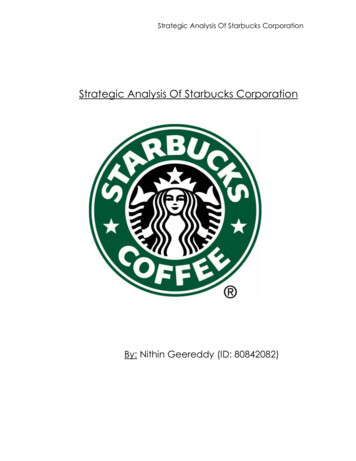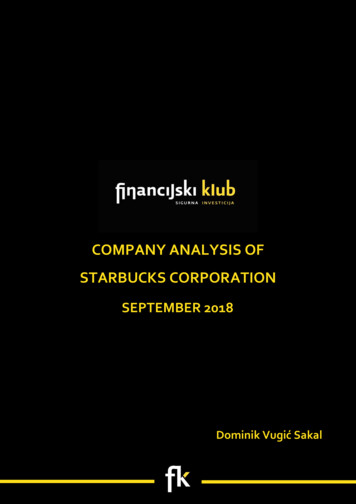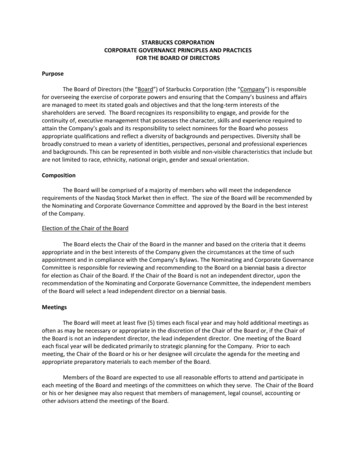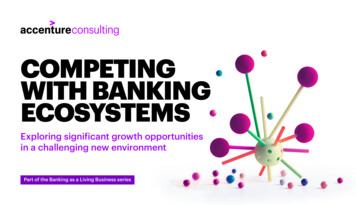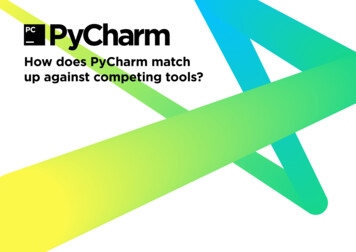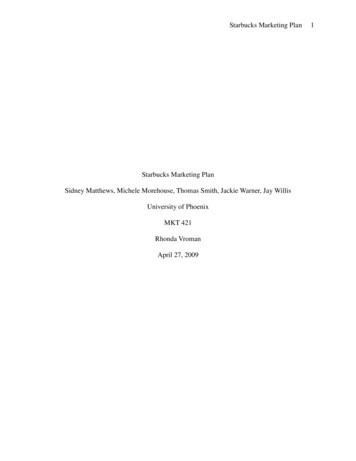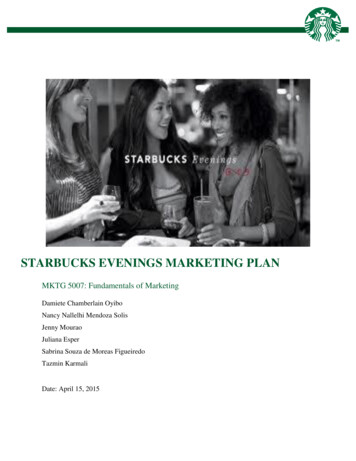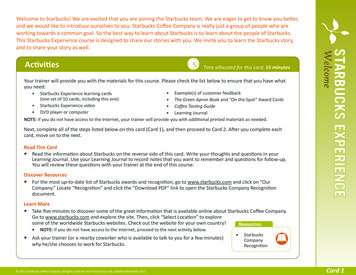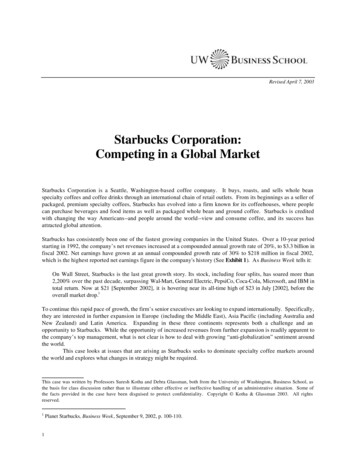
Transcription
Revised April 7, 2003Starbucks Corporation:Competing in a Global MarketStarbucks Corporation is a Seattle, Washington-based coffee company. It buys, roasts, and sells whole beanspecialty coffees and coffee drinks through an international chain of retail outlets. From its beginnings as a seller ofpackaged, premium specialty coffees, Starbucks has evolved into a firm known for its coffeehouses, where peoplecan purchase beverages and food items as well as packaged whole bean and ground coffee. Starbucks is creditedwith changing the way Americans--and people around the world--view and consume coffee, and its success hasattracted global attention.Starbucks has consistently been one of the fastest growing companies in the United States. Over a 10-year periodstarting in 1992, the company’s net revenues increased at a compounded annual growth rate of 20%, to 3.3 billion infiscal 2002. Net earnings have grown at an annual compounded growth rate of 30% to 218 million in fiscal 2002,which is the highest reported net earnings figure in the company's history (See Exhibit 1). As Business Week tells it:On Wall Street, Starbucks is the last great growth story. Its stock, including four splits, has soared more than2,200% over the past decade, surpassing Wal-Mart, General Electric, PepsiCo, Coca-Cola, Microsoft, and IBM intotal return. Now at 21 [September 2002], it is hovering near its all-time high of 23 in July [2002], before theoverall market drop.1To continue this rapid pace of growth, the firm’s senior executives are looking to expand internationally. Specifically,they are interested in further expansion in Europe (including the Middle East), Asia Pacific (including Australia andNew Zealand) and Latin America. Expanding in these three continents represents both a challenge and anopportunity to Starbucks. While the opportunity of increased revenues from further expansion is readily apparent tothe company’s top management, what is not clear is how to deal with growing “anti-globalization” sentiment aroundthe world.This case looks at issues that are arising as Starbucks seeks to dominate specialty coffee markets aroundthe world and explores what changes in strategy might be required.This case was written by Professors Suresh Kotha and Debra Glassman, both from the University of Washington, Business School, asthe basis for class discussion rather than to illustrate either effective or ineffective handling of an administrative situation. Some ofthe facts provided in the case have been disguised to protect confidentiality. Copyright Kotha & Glassman 2003. All rightsreserved.11Planet Starbucks, Business Week, September 9, 2002, p. 100-110.
BACKGROUNDIn 1971, three Seattle entrepreneurs—Jerry Baldwin, Zev Siegl, and Gordon Bowker—started selling whole-beancoffee in Seattle's Pike Place Market. They named their store Starbucks, after the first mate in Moby Dick.2 By 1982,the business had grown to five stores, a small roasting facility, and a wholesale business selling coffee to localrestaurants. At the same time, Howard Schultz had been working as VP of U.S. operations for Hammarplast, aSwedish house wares company in New York, marketing coffee makers to a number of retailers, including Starbucks.Through selling to Starbucks, Schultz was introduced to the three founders, who then recruited him to bringmarketing savvy to their company. Schultz, 29 and recently married, was eager to leave New York. He joinedStarbucks as manager of retail sales and marketing.A year later, Schultz visited Italy for the first time on a buying trip. He noticed that coffee is an integral part of theculture in Italy; Italians start their day at an espresso bar and later in the day return with their friends. There are200,000 coffee bars in Italy, and about 1500 in Milan alone. Schultz believed that, given the chance, Americans wouldpay good money for a premium cup of coffee and a stylish place to enjoy it. Enthusiastic about his idea, Schultzreturned to tell Starbucks’ owners of his plan for a national chain of cafes styled on the Italian coffee bar. Theowners, however, did not want to be in the restaurant business. Undaunted, Schultz wrote a business plan andbegan looking for investors. By April 1985 he had opened his first coffee bar, Il Giornale (named after the Italiannewspaper), where he served Starbucks coffee. Following Il Giornale's immediate success, he expanded to threestores. In 1987, the owners of Starbucks agreed to sell the firm to Schultz for 4 million. The Il Giornale coffee barstook on the name of Starbucks.Convinced that Starbucks would one day be in every neighborhood in America, Schultz focused on growth. At first,the company's losses almost doubled (to 1.2 million in fiscal 1990), as overhead and operating expenses balloonedwith the expansion. Starbucks lost money for three years running, and the stress was hard on Schultz, but he stuck tohis conviction not to “sacrifice long-term integrity and values for short-term profit.”3 In 1991 sales shot up 84 percent,and the company turned profitable. In 1992 Schultz took the firm public at 17 a share.Believing that market share and name recognition are critical to the company’s success, Schultz continued to expandthe business aggressively. Schultz observes, “There is no secret sauce here. Anyone can do it.” From the beginning,Schultz has professed a strict growth policy. Although many other coffeehouses or espresso bars are franchised,Starbucks owns all of its North American stores outright, with the exception of license agreements in airports.Further, rather than trying to capture all the potential markets as soon as possible, Starbucks goes into a geographicmarket and tries to completely dominate it before setting its sights on further expansion. Using this strategy,Starbucks has grown from 17 coffee shops in 1987 to 5,688 outlets in 28 countries by the end of fiscal 2002 (seeExhibit 2). It also employed over 60,000 individuals, including approximately 50,000 in retail stores at the end of 2002.Starbucks Corporation is organized into two business units that correspond to the company's operating segments:North American and International. In 1995, Starbucks Coffee International, a wholly owned subsidiary of StarbucksCoffee Company, was set up to build Starbucks’ businesses outside North America, including opening companyowned, licensed, and joint-venture-based retail stores worldwide.A recent article in Business Week notes :“Starbucks also has a well-seasoned management team. Schultz, 49, stepped down as chief executive in 2000 tobecome chairman and chief global strategist. Orin Smith, 60, the company's numbers-cruncher, is now CEO and incharge of day-to-day operations. The head of North American operations is Howard Behar, 57, a retailing expert2According to Business Week (September 9, 2002, p.103), “The name came about when the original owners looked to Seattlehistory for inspiration and chose the moniker of an old mining camp: Starbo. Further refinement led to Starbucks, after the firstmate in Moby Dick, which they felt evoked the seafaring romance of the early coffee traders (hence the mermaid logo).”3Success, April, 1993.2
who returned last September, two years after retiring. The management trio is known as H20, for Howard,Howard, and Orin.”4Exhibit 3 provides a partial list of Starbucks top management, and Appendix A provides a timeline and history ofStarbucks.THE STARBUCKS MODELHoward Schultz’s goal is to: “Establish Starbucks as the premier purveyor of the finest coffee in the world whilemaintaining uncompromising principles as we grow.” The company’s 25-year goal is to “become an enduring, greatcompany with the most recognized and respected brand in the world, known for inspiring and nurturing the humanspirit.” The company’s mission statement articulates several guiding principles to measure the appropriateness of thefirm’s decisions (see Exhibit 4). In describing Starbucks’ unique approach to competition, Fortune notes:The strategy is simple: Blanket an area completely, even if the stores cannibalize one another's business. A newstore will often capture about 30% of the sales of a nearby Starbucks, but the company considers that a goodthing: The Starbucks-everywhere approach cuts down on delivery and management costs, shortens customerlines at individual stores, and increases foot traffic for all the stores in an area. Last week 20 million peoplebought a cup of coffee at a Starbucks. A typical customer stops by 18 times a month; no American retailer has ahigher frequency of customer visits. Sales have climbed an average of 20% a year since the company wentpublic. Even in a down economy, when other retailers have taken a beating, Starbucks store traffic has risenbetween 6% and 8% a year. Perhaps even more notable is the fact that Starbucks has managed to generate thosekinds of numbers with virtually no marketing, spending just 1% of its annual revenues on advertising. (Retailersusually spend 10% or so of revenues on ads.)5Business Week adds:Clustering stores increases total revenue and market share, [CEO] Orin Smith argues, even when individualstores poach on each other’s sales. The strategy works, he says, because of Starbucks size. It is large enough toabsorb losses at existing stores as new ones open up, and soon overall sales grow beyond what they wouldhave with just one store. Meanwhile, it’s cheaper to deliver to and manage stores located close together. And byclustering, Starbucks can quickly dominate a local market.6And Schultz points out:The market is much larger than we originally thought. In most cases local competitors benefit from our arrivalbecause of the expansion of the marketplace. Our strategy is never to eliminate or hurt the competition. We neverunder-price our coffee and it's clear that we position ourselves so as not to undercut the pricing structure in themarketplace.Schultz observes that the company is still in its early days of growth worldwide. “We are opening three or four storesevery day,” he notes. “We feel strongly that the driver of the equity of the brand is directly linked to the retailexperience we create in our stores. Our commitment to the growth of the company is significant and will continue tobe based on the long-term growth potential of our retail format.”Securing the Finest Raw MaterialsStarbucks’ coffee quality begins with the purchase of high-quality arabica coffee beans. Although many Americanswere raised on a commodity-like coffee made from lower quality robusta beans (or arabica beans mixed with lessexpensive filler beans), Starbucks coffee is strictly arabica, and the company ensures that only the highest quality4Planet Starbucks, Business Week, September 9, 2002, p. 100-110.Mr. Coffee. Fortune, March 30, 2003.6Planet Starbucks. Business Week, September 9, 2002, p.103.53
beans are used. Dave Olsen, the company’s then senior vice president and then chief coffee procurer, scouredmountain trails in Indonesia, Kenya, Guatemala and elsewhere in search of Starbucks’ premium bean. His standardswere demanding, and he conducted exacting experiments in order to get the proper balance of flavor, body andacidity.From the company’s inception, it has worked on developing relationships with the countries from which it buyscoffee beans. Traditionally, Europeans and Japanese bought most of the premium coffee beans. Olsen sometimes hadto convince coffee growers to sell to Starbucks--especially since American coffee buyers are notorious purchasers ofthe "dregs" of the coffee beans. In 1992 Starbucks set a new precedent by outbidding European buyers for theexclusive Narino Supremo Bean crop.7 Starbucks collaborated with a mill in the tiny town of Pasto, located on the sideof the Volcano Galero. There they set up a special operation to single out the particular Narino Supremo bean, andStarbucks guaranteed to purchase the entire yield. This enabled Starbucks to be the exclusive purveyor of NarinoSupremo, purportedly one of the best coffees in the world.8Vertical IntegrationRoasting the coffee bean is close to an art form at Starbucks. Starbucks currently operates multiple roasting anddistribution facilities. Roasters are promoted from within the company and trained for over a year, and it is consideredquite an honor to be chosen. The coffee is roasted in a powerful gas-fired drum roaster for 12 to 15 minutes whileroasters use sight, smell, hearing and computers to judge when beans are perfectly done. The color of the beans iseven tested in an Agtron blood-cell analyzer, with the whole batch being discarded if the sample is not deemedperfect.The Starbucks ExperienceAccording to Schultz, “We’re not just selling a cup of coffee, we are providing an experience.” In order to createAmerican coffee enthusiasts with the dedication of their Italian counterparts, Starbucks provides a seductiveatmosphere in which to imbibe. Its stores are distinctive and sleek, yet comfortable. Though the sizes of the storesand their formats vary, most are modeled after the Italian coffee bars where regulars sit and drink espresso with theirfriends.Starbucks stores tend to be located in high-traffic locations such as malls, busy street corners, and even grocerystores. They are well lighted and feature plenty of light cherry wood and artwork. The people who prepare the coffeeare referred to as “baristas,” Italian for bartender. Jazz or opera music plays softly in the background. The storesrange from 200 to 4,000 square feet, with new units tending to range from 1,500 to 1,700 square feet. In 2003, theaverage cost of opening a new store (including equipment, inventory and leasehold improvements) is in theneighborhood 350,000; a “flagship” store costs much more.Building a Unique CultureWhile Starbucks enforces almost fanatical standards about coffee quality and service, the policy at Starbuckstowards employees is laid-back and supportive. They are encouraged to think of themselves as
The strategy is simple: Blanket an area completely, even if the stores cannibalize one another's business. A new store will often capture about 30% of the sales of a nearby Starbucks, but the company considers that a good thing: The Starbucks-everywhere approach cuts down on delivery and management costs, shortens customer
